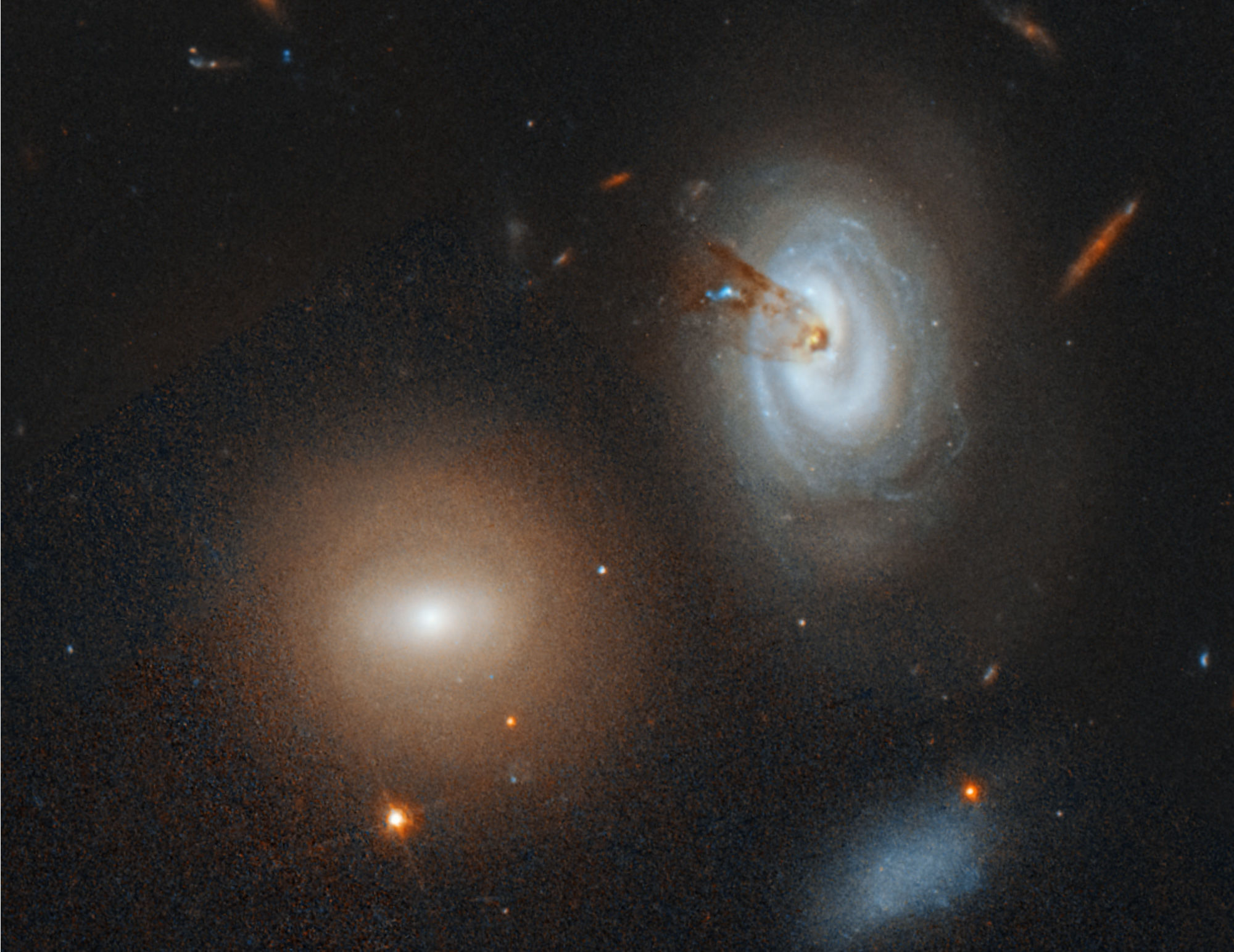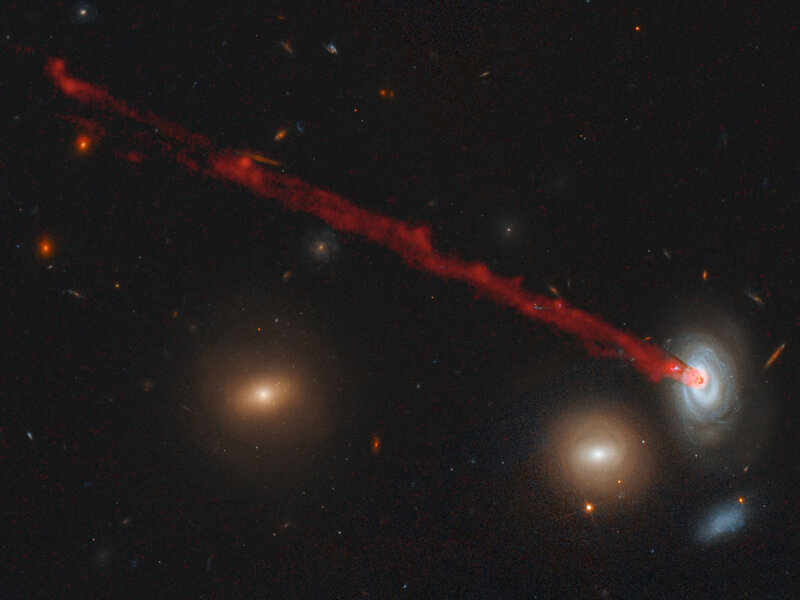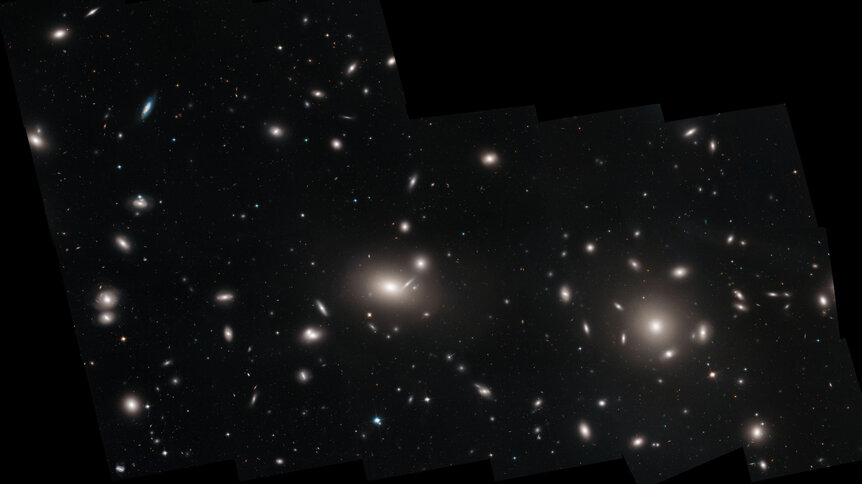Create a free profile to get unlimited access to exclusive videos, sweepstakes, and more!
How is a galaxy like a road-tripping dog?

So you're in your car with your dog, having a fun drive. At some point you notice something smells bad. Then, with growing horror, you realize it smells really bad. You glance at the dog, who has the time-tested "Who, me?" expression of innocence plastered purposefully on their face, and you know immediately what's going on and who the culprit is.
What do you do? Well, you have no choice: You open the window, and let the rushing air sweep the noisome foulness out of the car. You know you're leaving a long trail of mercaptan-laden gas behind the car, but it should disperse quickly enough.
OK, fun science fact: The same thing happens with galaxies.
Well, kinda. But to show you what I mean, meet D100, the tootiest galaxy of the Coma Cluster.
Whoa.
D100 is the blue spiral galaxy to the right, a flatulent — pardon me, flat — disk galaxy. That long, red streamer coming out of it is hydrogen gas. That streamer is incredibly long, over 200,000 light years from end to end — twice the length of our entire galaxy — yet is only about 7,000 light years wide, making it astonishingly narrow. It only expands about 50% from end to end, so it's like a very long, thin, cone.
What could cause this sort of thing? It's not like some other galaxy threw open the car's window, right?
Well, kinda.
Our galaxy, the Milky Way, is part of small clutch of a couple of dozen galaxies called the Local Group. You can think of it as a small galactic town. But sometimes galaxies live in cities, called galaxy clusters. There can be hundreds or even thousands of massive galaxies cohabiting in the cluster, held together by their mutual gravity. Each galaxy moves around the cluster center of mass, taking millions or billions of years to complete one orbit.
That's a long time, but clusters are big. Some galaxies scream around them at thousands of kilometers per second! The total gravity of the cluster is enormous, and can accelerate its member galaxies to high speeds (also, if two or three galaxies wind up passing close enough to each other, one can be flung away rapidly).
But the galaxies aren't alone out there. In between them, strewn throughout the cluster, is thin gas called the intercluster medium. There's not much of it, but when a galaxy plows through it at high speed, it can apply quite a bit of pressure on the galaxy. There's gas inside the galaxy, too (called the interstellar medium), and if conditions are right, the pressure from the gas on the galaxy moving through the cluster can be high enough to blow out the gas inside the galaxy. As the galaxy moves, it leaves that gas behind it.
So it is with D100. It is a member of the massive Coma Cluster, a mighty city of over 2,000 galaxies, lying about 350 million light years away from us. As D100 moves through the cluster, the intercluster medium is stripping that material away from it, blowing it away… hence the canine car flatus analogy.
The narrowness of the tail is odd. In general you'd expect it to puff up, expand, and dissipate. One reason may be that it is cooling rapidly; a hot gas wants to expand, and push against the intercluster medium. If the gas in the tail cools quickly enough the internal pressure drops, and it can stay narrow.
A tail can broaden due to the way the gas behaved when it was inside the galaxy, too. The gas orbits around the galactic center, and it'll keep that motion as it's blown back. As they orbit, a cloud of gas on one side of the galaxy moves one way, and a cloud on the other side will move in the opposite direction. If these two clouds are blown out by pressure stripping they will move in different directions, broadening the tail. It's possible that D100 is moving through the cluster edge-on, which will slow the speed of one of those clouds, causing it to flow more like the other. That would constrain the expansion as well.
Amazingly to me, the astronomers studying this galaxy found signs of stars forming in D100's tail! I would have naively thought the gas was too thin to collapse and form stars, and to be honest the star birth rate is low, less than 1% what we see in our own galaxy. Still, they seem to form in clumps a few hundred light years across with a few thousand to a few million stars each. That's pretty cool.
Incidentally, D100 itself is affected by all this, too. The gas from the outer parts of the disk leave first, since it's farther out from the center and not held as tightly by gravity as gas closer to the middle. Star formation appears to have ceased in the outer part of D100's disk, but you can still see spiral arms closer in, and that means it still has gas there, closer to the center. Eventually that too will be blown out; the whole process of cleaning out a galaxy takes roughly a billion years.
I've always wondered if you could have planets orbiting stars outside galaxies. This makes me wonder that again. What a view you'd have if you lived on one! The tail is likely too thin and faint to see even though you'd be embedded in it… but the view of D100 would be amazing if you're close enough. And you'd see hundreds of other galaxies in the sky, many easily visible to the naked eye. With binoculars, thousands. And in this case there would be thousands of stars in your sky as well, much like here on Earth. It would be spectacular.
The price that's paid is that D100 will die as the gas is stripped off, its ability to make new stars disappearing with that material. That's kind of sad, but I guess no matter what, when you get rid of a lot of gas, your situation stinks.

















